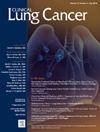RBM10 基因突变是非小细胞肺癌治疗的潜在阴性预后/预测生物标记物
IF 3.3
3区 医学
Q2 ONCOLOGY
引用次数: 0
摘要
根据世界卫生组织的数据,肺癌是全球癌症相关死亡的主要原因,但在过去十年中,肺癌的治疗取得了进展。随着下一代测序技术的广泛应用,发现了一些致病突变,包括RNA结合基序10 [RBM10],这是剪接体复合物的一部分,可调节前mRNA的剪接。我们利用电子病历创建了一个数据库,其中包含 2018-2023 年期间就诊的 NSCLC 患者 [50 名患者] 以及突变,并获得了适当的 IRB 批准。为了进行亚组分析,我们按照疾病快速进展与疾病稳定分为几组,定义为无进展生存期早于各自的临床试验。从治疗反应分析来看,突变人群的中位无进展生存期为6.7个月,而野生型RBM10人群的中位无进展生存期为13.9个月,受驱动基因突变控制的TP53突变在RBM10突变快速进展组中的代表性高于疾病稳定组。ZFHX3突变在RBM10突变稳定疾病组中具有更高的代表性。ZFHX3突变与侵袭性疾病有关,其治疗进展速度快于中位反应持续时间。随着下一代测序技术的广泛应用,发现了包括RBM10在内的多种致病突变。在一个NSCLC患者数据库中,突变与侵袭性疾病有关,治疗进展速度快于中位反应持续时间。同时发生ZFHX3和表皮生长因子受体突变的患者病情更稳定,而同时发生KRAS和TP53突变的患者病情会更加凶险。本文章由计算机程序翻译,如有差异,请以英文原文为准。
RBM10 Mutation as a Potential Negative Prognostic/Predictive Biomarker to Therapy in Non-Small-Cell Lung Cancer
Background
According to WHO, lung cancer is the leading cause of cancer-related death worldwide, but treatment has advanced in the last decade. The widespread use of Next Generation Sequencing has led to the discovery of several pathogenic mutations including RNA binding motif 10 (RBM10), a part of the spliceosome complex that regulates splicing of pre-mRNA.
Patients and Methods
Electronic medical records were utilized to create a database of patients (50 patients) seen from 2018-2023 with NSCLC and RBM10 mutations, with appropriate IRB approval. For subgroup analysis, we separated into groups by rapid progression vs stable disease defined as progression-free survival earlier than respective clinical trials.
Results
From the analysis of treatment response the mutated RBM10 population had a median PFS was 6.7 months compared to 13.9 in the wild-type RBM10 population controlled for driver mutations TP53 mutation had a higher representation in the RBM10 mutated rapid progression group than the stable disease group. The ZFHX3 mutation had a higher representation in the RBM10 mutated stable disease group.
Conclusions
RBM10 mutations were associated with aggressive disease with treatment progression faster than median durations of response. RBM10 mutations with concurrent ZFHX3 and EGFR mutations were associated with more stable disease, while concurrent KRAS and TP53 predicted even more aggressive disease.
求助全文
通过发布文献求助,成功后即可免费获取论文全文。
去求助
来源期刊

Clinical lung cancer
医学-肿瘤学
CiteScore
7.00
自引率
2.80%
发文量
159
审稿时长
24 days
期刊介绍:
Clinical Lung Cancer is a peer-reviewed bimonthly journal that publishes original articles describing various aspects of clinical and translational research of lung cancer. Clinical Lung Cancer is devoted to articles on detection, diagnosis, prevention, and treatment of lung cancer. The main emphasis is on recent scientific developments in all areas related to lung cancer. Specific areas of interest include clinical research and mechanistic approaches; drug sensitivity and resistance; gene and antisense therapy; pathology, markers, and prognostic indicators; chemoprevention strategies; multimodality therapy; and integration of various approaches.
 求助内容:
求助内容: 应助结果提醒方式:
应助结果提醒方式:


